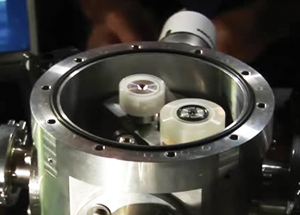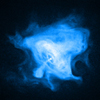Disclaimer: This material is being kept online for historical purposes. Though accurate at the time of publication, it is no longer being updated. The page may contain broken links or outdated information, and parts may not function in current web browsers. Visit chandra.si.edu for current information.
Are Black Holes Made of Scotch Tape?
News flash: Sticky tape generates X-rays
by WKT
November 24, 2008 ::
Recently a group of researchers from the University of California at Los Angeles announced what has been described by the New York Times as a "tour de force of office supply physics." The scientists measured X-ray flashes from a roll of Scotch tape as it was unpeeled.
You might wonder if this is relevant to X-ray astronomy, or then again you might not. But we did. After all, Galileo's observation of a chandelier set in motion by an earthquake and Newton's immortal apple led to insights that transformed the understanding of the cosmos.
Other, less dramatic but nevertheless significant examples abound. One that comes to mind is the insight that radiation from energetic electrons produced by synchrotron particle accelerators can explain the radiation from cosmic radio and X-ray sources such as the Crab Nebula, and many others whose images are displayed on Chandra's web page.
The mechanism for producing X-rays from Scotch tape is attributed to a process known as triboluminescence (from the Greek tribo, meaning to rub). The basic idea is that rubbing two surfaces together, or pulling 2 sticky surfaces apart, can create a charge separation. Combing your hair, or walking across a nylon rug, can do the same thing.
The voltages created in this process can be surprisingly large - in the Scotch tape experiment they reach about 300,000 volts! (The currents are very small, of the order of a few nano amps, so there is no need to worry about being electrocuted while wrapping presents.) Under appropriate, high vacuum conditions, these voltages can accelerate electrons to energies of many kilovolts. The energetic electrons will generate X-rays when they collide with atoms.
If a huge supply of Scotch tape existed out there in the cosmos, what kind of cosmic X-ray source would it produce? Put another way, how many standard rolls of Scotch tape would be needed to explain Cygnus X-1, the famous black hole X-ray source?
The average power observed from the Scotch tape used in the UCLA experiment was about 2 nanowatts. This means that about a thousand trillion trillion trillion (1039) rolls peeling at once would be needed. If all the rolls were packed tightly together, they would fill a volume roughly equal to the volume of a sphere that encompasses the orbit of Mars.
This immediately tells us that the Scotch tape hypothesis has no sticking power. The X-rays from this cosmic supply room could not show significant variability on a time of less that about 15 minutes, whereas Cygnus X-1 is observed to vary on a millisecond time scale.
There is also a problem with efficiency. Only about one millionth of the mechanical energy of the unwinding tape goes into the production of X-rays. It would be much more efficient to dump the rolls into an accretion disk around a black hole, let them get vaporized as the speed up and fall toward the black hole.
Does anything Chandra has observed look remotely like the Scotch tape process? The auroras from the magnetospheres of Jupiter and Earth come to mind. The solar wind combs the magnetic fields of these planets back into teardrop shapes that create high voltages that accelerate charged particles to energies sufficient to produce X-rays.
Similar processes are likely occurring in other sources where gas motions are pushing magnetic fields around to create high voltages. Winds from massive young stars impacting on smaller stars, or even jets generated by black holes are possible candidates.
Finally, we couldn't resist estimating the distance at which Chandra could detect an astronaut unraveling a roll of Scotch tape, which takes about 800 seconds in the UCLA experiment. A rough estimate indicates that the astronaut would have to be within about 200 meters for Chandra to detect the Scotch tape X-rays.
Reference: C.
Camara et al, 2008 Nature, 455, 1089
Disclaimer: This material is being kept online for historical purposes. Though accurate at the time of publication, it is no longer being updated. The page may contain broken links or outdated information, and parts may not function in current web browsers. Visit chandra.si.edu for current information.








